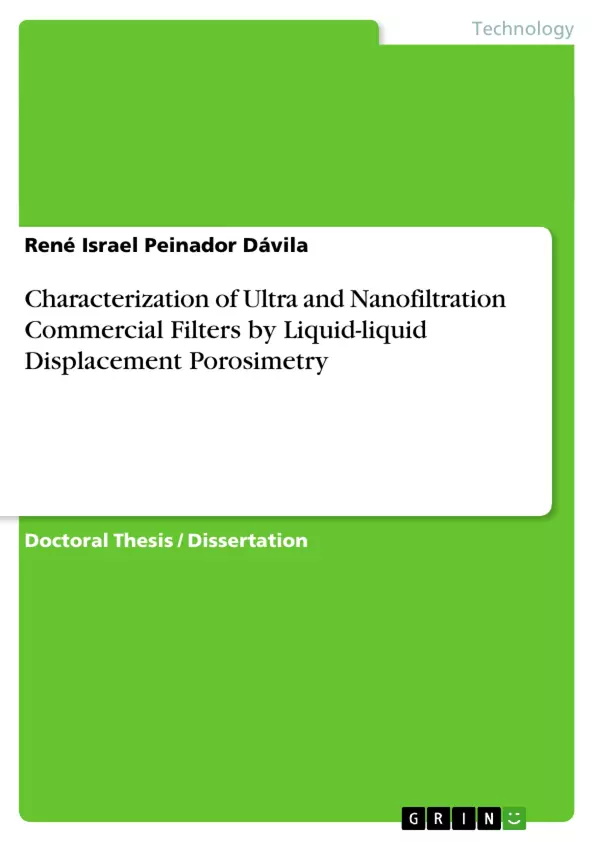Membrane Technology applied, among others, in processes such as Ultrafiltration (UF) and Nanofiltration (NF), has become an important part of biotechnological separation processes in recent decades. Its main feature, the morphology of the porous filters, leading to a “sieving mechanism” allows effective separation with high selectivity features and made in energy and environmental conditions very interesting.
Given the enormous development of membrane filters, it becomes necessary the growth in parallel of characterization techniques applied to such filters, as essential tools for both manufacturers and end-users or researchers.
In this sense we need to know most exactly possible, both functional and structural parameters of the membrane, all necessary for a proper choice of that with a view to a particular application.
The question we must face is: Is there a characterization method, by itself, giving us a clear and easily interpretable picture of the true structure and functionality of the filter?.
The answer to this question is obviously no. There are so many structural and functional parameters that contribute to the exact knowledge of the membrane, that there is no technique that can bring us all this wealth of information.
From the industrial and commercial standpoints, the parameter most used and required, in view of possible applications of the filters, it is the molecular weight cut-off (MWCO), although it is clear that by itself is not a definitive tool for choosing a membrane filter.
SMAP® group long experience in membrane characterization allows us to conclude that porosimetric techniques give interesting information related to the size and size distribution of the pores present in a membrane, information that can be conveniently checked against functional aspects of it.
In this sense, we can consider that Liquid-liquid displacement porosimetry (LLDP) is the most promising porosimetric technique in the range of Ultrafiltration, thus giving us important information about these filters.
Inhaltsverzeichnis (Table of Contents)
- Abstract
- Introducción (Introduction)
- Revisión bibliográfica (Literature Review)
- Metodología (Methodology)
- Resultados y discusión (Results and Discussion)
- Conclusiones (Conclusions)
- Bibliografía (Bibliography)
Zielsetzung und Themenschwerpunkte (Objectives and Key Themes)
This doctoral thesis presents the results of research conducted on the characterization of ultra and nanofiltration commercial filters using liquid-liquid displacement porosimetry. The objective of the study is to investigate and optimize this technique for the analysis of porous materials, specifically membrane filters. Key themes explored in the thesis include:- Liquid-liquid displacement porosimetry as a method for characterizing porous materials
- Applications of this technique to the analysis of ultra and nanofiltration membranes
- Development of experimental protocols for the accurate and reliable measurement of pore size distribution
- Assessment of the impact of different operating parameters on the porosimetry results
- Correlation of porosimetry data with the performance of membrane filters
Zusammenfassung der Kapitel (Chapter Summaries)
- Introduction: This chapter provides an overview of the field of membrane filtration and its importance in various applications. It introduces the different types of membranes, their characteristics, and the principles of filtration. The chapter also outlines the challenges associated with characterizing membrane pores and highlights the need for advanced techniques like liquid-liquid displacement porosimetry.
- Literature Review: This chapter reviews the existing literature on the application of liquid-liquid displacement porosimetry for the characterization of porous materials, particularly membrane filters. It discusses the strengths and limitations of the technique, compares it to other methods, and examines the factors that affect its accuracy and reliability.
- Methodology: This chapter details the experimental methodology employed in the research, outlining the materials and equipment used, the sample preparation procedures, and the specific steps involved in performing liquid-liquid displacement porosimetry measurements. It describes the data acquisition and analysis methods used to obtain pore size distribution information.
- Results and Discussion: This chapter presents the experimental results obtained from the characterization of ultra and nanofiltration membranes using liquid-liquid displacement porosimetry. It analyzes the pore size distribution data, discusses the influence of different operating parameters, and compares the results to those obtained using other characterization methods. The chapter also explores the correlation between porosimetry data and the performance of membrane filters in specific applications.
Schlüsselwörter (Keywords)
This doctoral thesis focuses on the characterization of ultra and nanofiltration commercial filters using liquid-liquid displacement porosimetry. Key terms include: membrane filtration, ultrafiltration, nanofiltration, liquid-liquid displacement porosimetry, pore size distribution, membrane characterization, filtration performance, and porous materials.- Quote paper
- René Israel Peinador Dávila (Author), 2013, Characterization of Ultra and Nanofiltration Commercial Filters by Liquid-liquid Displacement Porosimetry, Munich, GRIN Verlag, https://www.hausarbeiten.de/document/268782


